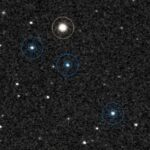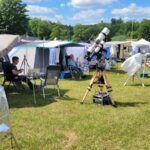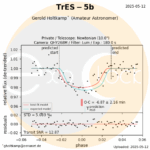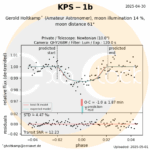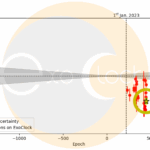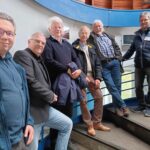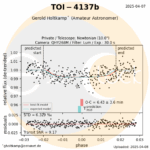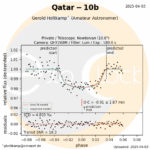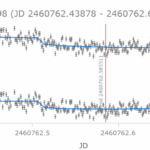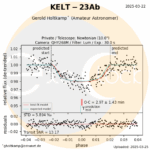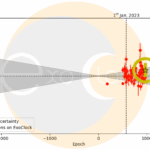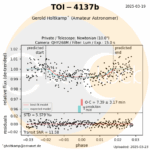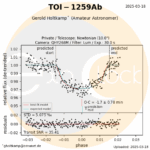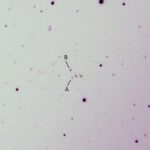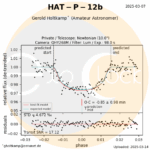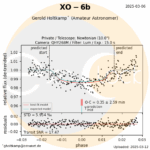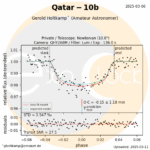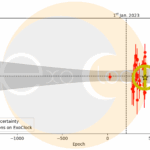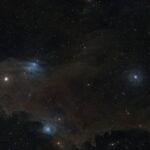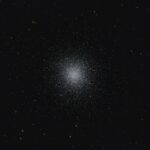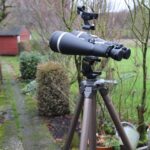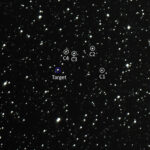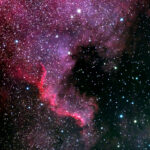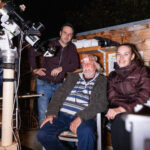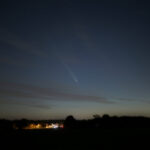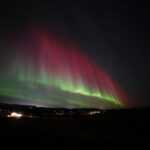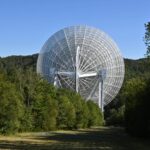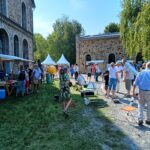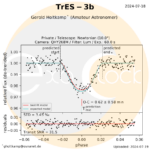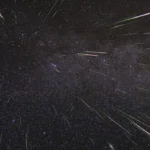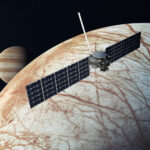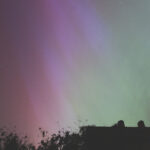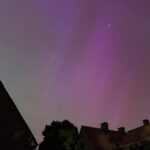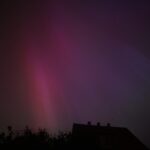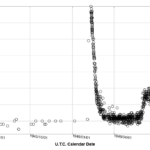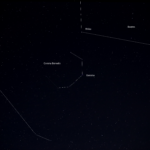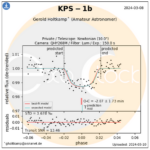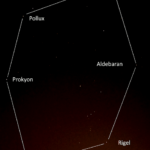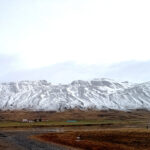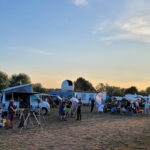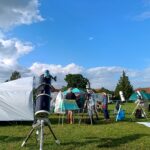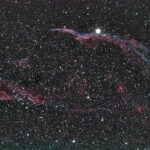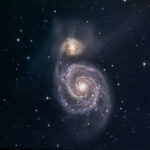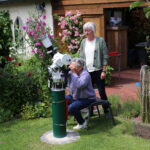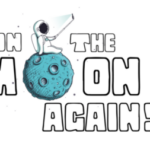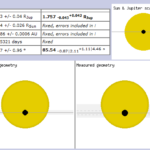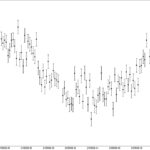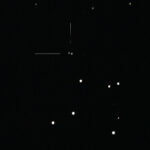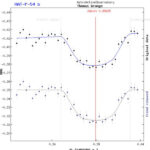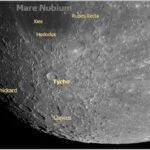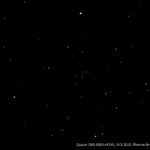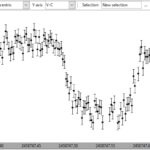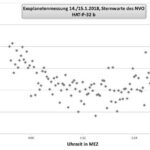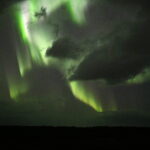Again and again we are busy with interesting astronomical topics or spend our time with projects that require a more detailed description. Here you can see our reports in chronological sorting. Since we work on different astronomical topics you can also find them in a sorted order by topic.
If you prefer an order according to topic have a look here.
If you are looking for a special expression you can search on all kosmos-os sites here:
- Photometry at ITVThe variable star T Coronae Borealis in the constellation Northern Crown is of interest at the moment, not only because it fluctuates regularly in brightness, but also because a nova event is imminent in the near future. At the ITV 2025 in Gedern, I was able to use one night to photometry this exciting star.
- Fascination SpaceExperiencing astronomy isn't just about gazing at the stars. As with many other pursuits, exchanging ideas with others who share a common interest is a significant motivating factor. The specially organized astronomy meetings are ideal for this. These bring together everyone who shares a passion for space. So, on Monday, May 26, 2025, the four of us—Werner, Thomas, Gerold, and Burkhard—set out from various locations in and around Osnabrück toward Lake Gedern in the Vogelsberg Mountains.
- Measurement of the transit light curve of the exoplanet TrES-5b on May 11/12, 2025The exoplanet and its parent star are located in the constellation Cygnus, on the border with Cepheus. The measurements were taken from May 11, 2025, 10:13 PM UTC to May 12, 2025, 1:57 AM UTC in Osnabrück, Sonnenhügel. The moon was 99% illuminated but 104° away, so it could not shine into the telescope. It rose on May 11, 2025, at 6:22 PM UTC and set on May 12, 2025, at 3:00 AM UTC.
- TON 618 – the giantOn April 26, 2025, I took a photograph showing an area on the border between the constellation Canes Venatici and the constellation Coma Berenices. It's probably the most unspectacular photograph I've ever taken. However, among the recognizable stars and objects is my personal record holder.
- Measurement of the transit light curve of the exoplanet KPS-1b on April 30/May 1, 2025The exoplanet and its parent star are located in the constellation Ursa Major. The measurements were taken from April 30, 2025, at 9:11 p.m. UTC to May 1, 2025, at 12:49 a.m. UTC in Osnabrück, Sonnenhügel. The Moon was 14% illuminated and 61° distant. It rose at 4:55 a.m. UTC on April 30, 2025, and set at 11:26 p.m. UTC, but its dim illumination was not yet disturbing.
- Measurement of the transit light curve of the exoplanet TOI-1811b on April 27/28, 2025The exoplanet and its parent star are located in the constellation Coma Berenices. The measurements were taken from 23:00 UTC on April 27, 2025, to 2:54 UTC on April 28, 2025, in Osnabrück, Sonnenhügel. The Moon was illuminated at 0.2% and therefore not obstructive.
- Excursion to the Olbers Gesellschaft Bremen on April 22, 2025Originally, we had only planned to attend the lecture "Measuring the Invisible Universe with the Help of Gravitational Wave Detectors" at the Olbers Gesellschaft Bremen. Since we knew that the lecture would take place in the building of the University of Bremen, which also houses the Walter Stein Observatory, we inquired whether a short tour of the historic observatory would be possible.
- Measurement of the transit light curve of the exoplanet TOI-4137b on April 7/8, 2025The measurements were taken from 7:26 p.m. UTC on April 7, 2025, to 12:51 a.m. UTC on April 8, 2025, in Osnabrück, Sonnenhügel. The moon was 78% illuminated and 66° distant. It set at 3:24 a.m. UTC on April 8, 2025, and was therefore visible throughout the entire measurement period. It could therefore have shone into the telescope and potentially influenced the measurement accuracy.
- Transit light curve of the exoplanet Qatar-1b on June 6th/7th April 2025The measurements were taken from 10:07 p.m. UTC on April 6, 2025, to 2:24 a.m. UTC on April 7, 2025, in Osnabrück, Sonnenhügel. The moon was 70% illuminated and 93° distant. It set at 3:03 a.m. UTC on April 7, 2025, and was therefore in the sky for the entire measurement period. However, because it was 93° distant, it could not shine into the telescope.
- Measurement of the transit light curve of the exoplanet Qatar-10b on 2/3 April 2025The measurements were taken from 21:55 UTC on April 2, 2025, to 3:27 UTC on April 3, 2025, in Osnabrück, Sonnenhügel. The moon was 27% illuminated and 64° distant. It set on April 3, 2025, at 0:15 UTC.
- Partial solar eclipse on March 29, 2025On Saturday, March 29, 2025, a partial solar eclipse occurred, clearly visible from Osnabrück. From 11:21 a.m. to 1:05 p.m., the Sun was covered by the Moon. At its peak at 12:13 p.m., 21.08% of the Sun was obscured. For this event, we organized a “Sternstunden Special”.
- Measurement of the transit light curve of the exoplanet Qatar-8b on March 31/April 1, 2025The measurements were taken from 9:26 p.m. UTC on March 31, 2025, to 3:06 a.m. UTC on April 1, 2025, in Osnabrück, Sonnenhügel. The moon was 10% illuminated and 78° distant. It set on March 22, 2025, at 10:30 p.m. UTC. It was therefore not relevant for the measurement.
- Measurement of the transit light curve of the exoplanet TOI-1298b on March 27/28, 2025The measurements were taken from 22:32 UTC on March 27, 2025, to 4:27 UTC on March 28, 2025, in Osnabrück, Sonnenhügel. The moon was illuminated at 3% and 101° away. It was therefore not relevant for the measurement.
- Measurement of the transit light curve of the exoplanet KELT-23Ab on March 21/22, 2025The measurements were taken from 10:21 PM UTC on March 21, 2025, to 2:37 AM UTC on March 22, 2025, in Osnabrück, Sonnenhügel. The moon was 55% illuminated and 98° distant. It rose at 3:30 AM UTC on March 22, 2025. It was therefore not relevant for the measurement.
- Measurement of the transit light curve of the exoplanet TOI-1516b on March 20/21, 2025The measurements were taken from 10:39 PM UTC on March 20, 2025, to 3:34 AM UTC on March 21, 2025, in Osnabrück, Sonnenhügel. The moon was 64% illuminated and 115° distant. It rose at approximately 1:15 AM UTC on March 21, 2025, but only reached a maximum altitude of 9° above the horizon. It was therefore of little relevance for the measurement.
- Measurement of the transit light curve of the exoplanet TOI-4137b on March 19/20, 2025The measurements were taken from 7:19 PM UTC on March 19, 2025, to 12:39 AM UTC on March 20, 2025, in Osnabrück, Sonnenhügel. The moon was 74% illuminated and 133° distant. It rose at approximately 12:15 AM UTC on March 20, 2025, and was therefore hardly relevant for the measurement.
- Measurement of the transit light curve of the exoplanet TOI-1259Ab on March 18, 2025The measurements were taken from 12:14 a.m. UTC on March 18, 2025, to 4:32 a.m. UTC on March 18, 2025, in Osnabrück, Sonnenhügel. The Moon was 87% illuminated and 103° distant. It set around 6:05 a.m. UTC. Sunrise was already around 5:30 a.m. UTC, which is why measurements could only be taken until about half an hour after the end of the transit.
- Mirage in the SkyThe observation of the three quasars Q0957+561, RXJ0921+4529, and SDSS J1029+2623 is described. In these cases, multiple images are generated by galaxies or galaxy clusters in the foreground, which act as gravitational lenses. It is shown that these images can be resolved even at an urban observation site.
- Measurement of the transit light curve of the exoplanet HAT-P-12b on March 7/8, 2025The measurements were taken from 9:42 PM UTC on March 7, 2025, to 2:00 AM UTC on March 8, 2025, in Osnabrück, Sonnenhügel. The moon was 64% illuminated and 87° distant. It set around 4:25 AM UTC.
- Measurement of the transit light curve of the exoplanet XO-6b on March 6/7, 2025The measurements were taken from 9:27 PM UTC on March 6, 2025, to 2:20 AM UTC on March 7, 2025, in Osnabrück, Sonnenhügel. The moon was 54% illuminated and 46° distant. It set around 2:15 AM UTC.
- Measurement of the transit light curve of the exoplanet Qatar-10b on March 5/6, 2025The measurements were taken from 11:28 PM UTC on March 5, 2025, to 4:11 AM UTC on March 6, 2025, in Osnabrück, Sonnenhügel. The moon was 43% illuminated and 80° distant. It set around 1:00 AM UTC.
- Measurement of the transit light curve of the exoplanet TOI-2154b on March 4/5, 2025The measurements were taken from 7:20 PM UTC on March 4, 2025, to 12:16 AM UTC on March 5, 2025, in Osnabrück, Sonnenhügel. The moon was 28% illuminated and 63° distant. It set at 12:20 AM UTC. During the measurement, some cirrus clouds passed through.
- Big, black, hot and with a short life expectancyThe measurement of the transit light curve of the exoplanet Wasp-12b is described. This exoplanet is special in many ways. The large number of existing transit light curves, including our own measurements, enables spectacular predictions about the lifespan of the exoplanet.
- The World of Dark Nebulae The vast majority of astrophotos show luminous objects such as galaxies, stars, luminous nebulae or supernova remnants. This is about dark nebulae, which appear dark with their dust and gas and are all the more difficult to spot, although they are all the more interesting as the origin of the stars. Beverly Lynds, who made an invaluable contribution in this field, is remembered.
- Sternstunden in January 2025 – a planets eveningOn January 18, 2025, we at kosmos-os, together with the Museum of Industrial Culture, invited to the Sternstunden on the Vosslinke at the Piesberg starting at 5:30 p.m.. About 30 visitors accepted the invitation and had the opportunity to look at the planets Venus, Saturn, Jupiter and Mars with us in the telescope.
- Globular clusters – fascinating and ancient giantsGlobular clusters turn out to be true jewel boxes in the night sky when magnified appropriately in the telescope. Hundreds of thousands or even millions of stars standing together in a spherical structure in one spot – often up to over 30,000 light-years away from us. But what exactly are globular clusters and are they all the same?
- A red dot finder on binocularsBinoculars with a red dot finder are a fine thing. With a little skill, something like this can quickly be built by yourself.
- Measurement of the transit light curve of the exoplanet TOI-2570 bThe measurement of the transit light curve of the exoplanet TOI-2570 b, which was only discovered in 2022, is described. The brightness of the parent star, which is located in a very dense field of stars, was determined in 148 images in relation to comparison stars. The result agrees very well with the data known so far.
- The UV source in the “Bahamas” and star birth in the “Gulf of Mexico” – The North American Nebula NGC 7000On October 25th and 27th, 2024, the author photographed the North American nebula from an urban garden. Its appearance gives the nebula its name. The article is less about its appearance and more about some of the astrophysical properties of the nebula and the objects within it.
- Visit to my observatoryOn Wednesday, October 16th, 2024, a volunteer from the Neue Osnabrücker Zeitung (NOZ) and a photographer were with me to report on my hobby of astronomy, the comet C/2023 A3 (Tsuchinshan-ATLAS) and the “supermoon”. The article should appear in the online edition of NOZ.
- The Comet C2023 A3 / Tsuchinshan-ATLASComets have always stirred people's minds and led to amazement, ecstasy or fear. We take a closer look!
- All good things come in threesThe sun has reached its maximum in its eleven-year activity cycle. For the third time this year, northern lights could be observed from Central Europe. A short excursion into the personal experiences of some kosmos-os friends at the Northern Lights on October 10, 2024 is presented.
- Play of colours over IcelandA travelogue about the excursion to the Northern lights in Iceland in September/October 2024
- Excursion to the Effelsberg radio telescopeYou have to drive very far from Osnabrück to get to the end of the visible universe or - to be more precise - to get to where you can "see" almost to this end. So six astro friends from kosmos-os set off from Osnabrück on Saturday, September 21st, 2024 at 7 a.m.
- Sternstunden with Saturn and MoonOn Sept. 14th, 2024 kosmos-os together with Museum Industriekultur invited to the Sternstunden on the Vosslinke on the Piesberg in Osnabrück. The weather was merciful to us and allowed us to look into a cloudless starry sky. About 25 interested visitors had come to admire the stars, the moon and the planet Saturn with us through our telescopes.
- 30th anniversary of the Museum Industriekultur – kosmos-os was thereThe Museum of Industrial Culture Osnabrück (MIK) had asked whether we at kosmos-os would take part in the planned birthday party on Sunday, September 1st, 2024. After all, there is a proven good cooperation with our Sternstunden on the Vosslinke. We were happy to comply with the request.
- TrES-3b, HAT-P-18b, TOI-2154b and TOI-1251.01The measurements of the transit light curves of the exoplanets TrES-3b, HAT-P-18b, TOI-2154b as confirmed and TOI-1251.01 as unconfirmed exoplanet are described. Each of them has peculiarities that make it worthwhile to take a closer look at them.
- Two in one fell swoop – northern lights and shooting stars in the sky above OsnabrückShooting stars in August? Everyone has heard of this before. Northern lights over Osnabrück? We already had that this year! But shooting stars and auroras together in one night over the Osnabrück region? That's not possible! Yes, it is!
- The Open Observatory in the Open GardenIn the Osnabrück region, many private gardens are opened to the general public every summer. Their owners have come together to form the “Open Garden Gate Osnabrück and the surrounding area”. Anyone interested can get to know a variety of garden ideas. This was also the case on Sunday, August 4, 2024, in the garden on Moorlandstrasse in Osnabrück. The special thing here: There is a garden observatory.
- The PerseidsThe Perseids are probably the most well-known recurring meteor shower. It triggers the shooting stars that can be observed well in August. The name "Perseids" derives from the direction the shooting stars seem to come from, the so-called radiant in the constellation Perseus..
- On The Moon Again 2024The moon. Everybody knows it. Everyone has seen it in the sky. It has been sung about countless times in poems and songs. Its influence on the earth is great. No wonder, after all, it is our closest cosmic neighbor. So why not take a close look at the Moon, not only with the naked eye, but also with an optical device?
- Mission EUROPA CLIPPEROn Saturday, June 9th, 2024, kosmos-os provided information about a new spectacular NASA space mission to Jupiter's moon Europa in October 2024 as part of a lecture at the Innovations Center Osnabrück (ICO). In front of ten interested listeners, Dr. Achim Tegeler reported on the current status of the development of the Europa Clipper Mission.
- Northern lights above EuropeIt was a special night from May 10th to 11th, 2024. Northern lights could be seen all over Europe. We didn't miss the impressive spectacle. In the article, the seven observers from kosmos-os are linked via a map showing their locations. Everyone reports his recordings and some videos on his own page. A short text reflects his own special experience.
- Aurora above IckerThe forecasts for the sighting of Northern Lights promised a lot. And quite unusual for these latitudes lately: the weather should play along. I wanted to observe together with our kosmos-os colleague Gerold Holtkamp. The observation site had not yet been determined. But here in Icker in the district of Osnabrück it is dark, no light in sight. So we decided to stay here and observed in front of the house and later in the garden
- Aurora above Alsace, FranceOn the evening of the tenth of May, messages from NOAA (National Oceanic and Atmospheric Administration) came practically every minute, reporting the ever-increasing Kp index. Time to take a closer look at the sky, although at 48° North you can rarely see auroras. And yes, there was a reddish-violet, barely perceptible shimmer in the night sky visible to the naked eye. So the noble drink was put aside and the camera was set up.
- Northern lights obove DissenAt around 9:00 p.m. on May 10th, 2024, I simply placed an Allsky camera in the garden and had it recorded overnight. The best of the approximately 800 photos are shown here. At the same time, I observed the Northern Lights with my naked eyes.
- Aurora above OffeltenAt first I was quite disappointed by all the auroras, because it was very bright in the north and you could only see a few red auroras without structures. In addition, there was a thin layer of altostratus clouds.
- Aurora above Buxton, Peak District, UKOn the evening of May 10th, we were standing with the camper at the campsite near Buxton in the Peak District in England. Since it was reasonably clear I looked up at nightfall to do some astrophotography with the Seestar.
- Northern lights obove AchmerSince I have been dealing with the topic of astronomy, there have been promising forecasts for the northern lights over Germany from time to time. So far, however, I have never had any success with it in this country, neither visually nor photographically. Until now.
- Northern lights obove the Osnabrück regionIn recent years I have experienced a number of northern lights on my trips to the Arctic Circle*. However, when the first warning messages from NOAA (National Oceanic and Atmospheric Administration) arrived by email on May 9th, announcing a Kp value of 8 for May 11th and 12th, I knew that something special was coming. Northern lights over the Osnabrück region. I had never experienced that before!
- T Coronae Borealis – The Nova in the futureA star in the constellation Northern Crown is described, for which a drastic increase in brightness is expected this year 2024. The historical events of this nova are discussed, but above all the current state of knowledge about this star, which lights up regularly about every 80 years.
- Corona Borealis - The Northern CrownThe constellation Corona Borealis is easily found between the constellations Bootes and Hercules. It shows an open-to-the-top ring structure formed by seven relatively well-recognizable stars. We find very interesting stars here...
- Measurement of the transit light curves of the exoplanets WASP-84b and KPS-1b on March 7 and 8, 2024The measurement of the transit light curves of the exoplanets WASP-84b and KPS-1b is described. The radius of the exoplanets is determined from the degree of “darkening” of the parent stars. The transit method makes this possible, although the two systems can only be observed as point sources of light.
- Hands-on scienceA travelogue about the excursion of kosmos-os to the ZARM Center for Applied Space Technology and Microgravity and to the Universum Bremen on April 13, .2024
- De Mairan's Nebula - M 43The De Mairan Nebula, which is directly adjacent to the Great Orion Nebula, is often not mentioned at all when observing the entire region around the constellation Orion. But it may be the cause of the spectacularly glowing HII regions on the Sword of Orion.
- The Horsehead Nebula in Orion - B33The closest active star-forming region to Earth is in the constellation Orion in the so-called Horsehead Nebula. Over the past two decades, a great deal of research has been done to understand its structural structure and the mechanisms at work within it.
- The star Betelgeuse - a Red SupergiantBetelgeuse, Orion's left shoulder star, is a Red Supergiant that has become the focus of science and, of course, amateur astronomy at the latest after its significant brightness dimming at the end of 2019. The purpose of this summary is to present the current state of the facts about Betelgeuse.
- The Orion Nebula – M42The Orion Nebula or M42 is probably one of the most striking and therefore well-known deep sky objects in the nighttime winter sky.
- The Orion constellation and surroundingThe Winter Hexagon represents an asterism composed of six stars from six different constellations. It consists of the very bright stars Capella in the constellation Auriga, Aldebaran in Taurus, Rigel in Orion, Sirius in Canis Majoris, Procyon in Canis Minor and Pollux in Gemini – in the sky, these stars form a beautiful hexagon, in the middle of which Orion can be found.
- And yet it moves...Anyone who has ever had to transport a 12" Dobsonian Goto telescope including rocker box and various additional parts such as power supply, finder telescope etc. knows that you don't necessarily want to carry the weight many meters even with two people. So, a trolley is needed...
- Special honour for Dr. Gerold Holtkamp by the AAVSOThe American Association AAVSO has now honored Dr. Gerold Holtkamp for his achievements as an amateur astronomer in the field of observation and measurement of variable stars and exoplanets.
- Measurement of the transit light curve of the exoplanet TOI 3952.01 on January 10, 2024The measurement of the transit light curve of the exoplanet TOI 3952.01, 1929 light years away, is described. It is a recently discovered exoplanet. The own measured data are compared with the few available literature values.
- Sternstunden on January 19th, 2024 on the Vosslinke at Osnabrück's PiesbergThe Sternstunden of January 19, 2024 are described. 23 visitors gathered on the Vosslinke on Piesberg to look into space. Moon, Jupiter, Orion and Andromeda Nebula, there was a lot to see.
- Cold feet and clammy hands during astrophotography – that was yesterdayThere are many garden observatories used by amateur astronomers and almost as many different concepts that are followed in their construction and operation. That's why it's always worth visiting such an observatory.
- "Pan Tau" – or the unobstructed view of spaceDew is always a problem in astronomical observations. Here is a description of how to build a secondary mirror heater for Newtonian telescopes so that the dew no longer has a chance.
- "Sternstunde" with PlanetsA "Sternstunde" is described, which is regularly offered by kosmos-os.de as so-called sidewalk astronomy. Although Osnabrück is heavily lightpolluted interesting observations of the sky were made.
- Occultation of Venus by the Moon on November 09, 2023Not being able to observe an interesting astronomical event due to bad weather is part of an astronomer's fate. But that doesn't mean you can't still take a closer look. That is exactly what this report does.
- The northern light dances in the Arctic CircleThe report describes what has to be taken into account for successful sightings of the northern lights. In addition, factors that cannot be influenced, such as the weather and the space weather, are also mentioned. Recordings and videos of the northern lights are shown. In addition, numerous sources are listed for more detailed information.
- Transit light curve of the exoplanet TOI-1259 A b on September 25th/26th, 2023The transit of the exoplanet TOI-1259 A b in front of its parent star, which is a component of a binary star system, is shown. The light curve recorded agrees well with the measurements of other authors. A detailed error analysis provides information on how to further improve this sensitive measurement method.
- Guest at the Herzberg Telescope Meeting, HTT 2023The weekend promised good astro weather and so I packed my pile of astro stuff and drove spontaneously from Osnabrück to Jeßnigk in southern Brandenburg. It was to be my first visit to the Herzberg Telescope Meeting (HTT).
- Construction of a dew capThe construction of a dew cap for a Newton telescope with a 250 mm aperture is described. Simple and therefore inexpensive means are used, essentially an insulating mat and a Velcro strip. The work process is described step by step.
- WHAT –The "Westhavelländer Astro Treffen" 2023Anyone who thinks astronomy takes place outside in the cold night does not know Gülpe in the Westhavelland. Every year, the WHAT – Westhavelländer Astro Treffen takes place there. Gülpe is located in one of the darkest areas of Germany.
- The Cirrus Nebula in SwanAn image of the Cirrus Nebula with a total exposure time of over four hours is presented. The location of the recording was in the urban area of Osnabrück, which was badly affected by artificial lighting. Nevertheless, the fine structures of this object could be imaged.
- Whirlpool galaxy (M51)The image shown is composed of several images from different projects: variable measurement, exoplanet measurement, etc. in the period from 2015 to 2020
- Observation of the sun at the event "Offenes Gartentor"On selected dates throughout the year, private gardens in Osnabrück and the surrounding area open their gates to give visitors a glimpse into their private green paradises. Such an "open garden gate" is also a good opportunity to present the most important factor for greenery and bloom – our sun!
- On The Moon Again 2023Since 2019, astronomers in over 60 countries around the world have been commemorating the first moon landing in 1969 every year. We have been involved from the very beginning and support this project. At our "On The Moon Again" events, we show the moon to all interested parties and share our fascination for astronomy.
- Building a parallelogram mount for astronomical binocularsBeing able to see astronomical objects with both eyes is a dream of many astronomers. That works ideally with a parallelogram mount for astronomical binolculars - and that's exactly what is built here!
- Measurement of the Transit Lightcurve of Exoplanet TrES-3 bThe transit light curve of the exoplanet TrES-3 b was recorded and measured on May 27th and 28th 2023. The method used and the specific observation conditions are explained. The results are presented and discussed based on an evaluation in the international Exoplanet Transit Database (ETD). The own result is a contribution in the context of so-called citizen science for further exploration of exoplanets.
- Inside and outside our Milky WayColor images with the mono camera QHY268M are shown. For this purpose, Fab filters are also used. The particular challenge was that one object stood above the bright city center of Osnabrück and the other object was very disturbed by the moon with 70% illuminated area.
- Komet C/2022 E3 (ZTF)A comet is a fleeting visitor. This also applies to comet C/2022 E3 (ZTF). On December 31, 2023 it was in the northern sky over Osnabrück and on February 13, 2023 it was already in the south. The following photos were taken from a garden in Osnabrück.
- "Just" discovered - Exoplanet TOI-1259 A bThe transit light curve of the exoplanet TOI-1259 A b, discovered just two years ago, was measured. The data determined agree well with literature values. It is a double star system, which is additionally interesting. The close position at the north celestial pole allows interesting further observations.
- "boundless vastness" @ HomeIn the constellation Draco you can find exoplanets that are particularly bright. They can therefore be easily photometrically analyzed with small apertures. The measurement of the transit light curve of the exoplanet Qatar-10b is described. It was discovered in 2019 and confirmed as such.
- The star HD189733 and its planet HD189733bUsing the star HD189733 and its exoplanet 189733b, it is shown that even with a relatively small instrument from an urban light-polluted area, interesting meaningful measurements of stellar rotation and planetary transit in front of its parent star can be carried out. In addition, the synopsis of the results of many amateur astronomers worldwide enables further insights.
- Impressions of the WHAT 2022Over the Westhavelland Star Park you can find obne of the darkest skies in Germany. This reputation was confirmed again this year at the 11th Westhavelländer Astrotreff (26th to 30th August 2022). At this meeting, astronomers from all over Germany come together to observe and exchange ideas together. Our own impressions at this meeting are presented here.
- The way to a telescope column in the gardenIt's always nice when you can initiate something. This was also the case on July 30th, 2022, when my astronomical colleagues and I inaugurated my new telescope column together. In the best weather and 3c (coffee, cake, cold drinks) the "ceremonial act" took place. Before that, of course, lays the history of the column, a slightly longer story …
- Objects of the southern skyIn Namibia, far away from civilization and thus all artificial lights, there is the Astro-Farm Rooisand. Here, from May 26th to June 1st 2022 many photos of objects of the southern sky were taken. A selection is presented.
- Aurora over IcelandA trip to Iceland from March 23rd - 31st, 2022 is reported. The island is almost on the Arctic Circle and is therefore very suitable for observing the northern lights. However, many factors have to be favorable to be successful. The weather and therefore the cloud density are important factors. Of course, there is also the fact that enough solar wind must arrive on Earth to produce the luminous phenomena.
- Exoplanet XO-2 N b at 27th February 2022Two sun-like stars (yellow dwarfs) orbit each other 486 light-years away in the constellation Lynx. Both stars, XO-2 N and XO-2 S, have a total of three exoplanets detected using the transit method. With amateur means, one of these exoplanets, XO-2 N b, could be detected on February 27, 2022 by a light curve.
- Observation of the quasars QSO J 1723+2243 and SPIT J17210+6017The observation of two very distant quasars is described. These are extremely faint objects that can only be imaged with powerful telescopes. A very light-sensitive camera is also required.
- The Nova V1405 CAS in CassiopeiaThe observation of the Nova V1405 CAS is described. Brightness measurements were carried out over a longer period of time, from April 1st, 2021 to May 15th, 2022. Together with measurements from other international authors, an atypical behavior for a nova was demonstrated.
- Hot Jupiter with an uncooled DSLRThe measurement of the light curve of the exoplanet Qatar-1 b with an uncooled DSLR camera is described. The challenge is to achieve a meaningful result despite the high noise.
- The Twin Quasar QSO 0957+561ABThe moon had already risen at night at 10:30 p.m. CET on March 2, 2021, but was still low on the horizon. With 83% illuminated pane, it would soon become a fairly bright "lantern". But the author was not deterred by this.
- Light curve of the exoplanet HAT-P-54bThomas Grunge did not only take a picture in his garden, but a light curve of the exoplanet HAT-P-54b. This planet does not orbit around our sun, but around the star HAT-P-54, whose light has been on its way to us for 443 years. This planet can no longer be seen directly, but can only be detected when it passes in front of the star and slightly obscures the star's light.
- A little moon walkA video of 1000 pictures was taken of the waxing moon (moon age about 10.5 days) which was also favorable in the sky. From this, a high-resolution image was created, on which many details of the lunar surface are recognizable. These different geological structures are presented and explained.
- Quasar J0209+0517The image of the quasar J0209+0517 is described. At first, nothing can be seen on individual shots. The addition of several shots brings the desired success.
- The impressive comet C/2020 F3 NeowiseA bright comet doesn't appear in the sky very often. We may have to wait another decade or more. Comet Neowise was an impressive sight in the sky! Why was a comet in earlier times a sign of coming disaster when it is actually just beautiful?
- Almost at the "edge of the universe" – the quasar QSO J0831+5245Thomas Grunge and Gerold Holtkamp imaged the quasar QSO J0831+5245 on May 14th 2020 with the Cassegrain telescope (60 cm mirror diameter, 746 cm focal length) of the NVO Observatory. Its speed alone is record-breaking: 276,000 km/s (according to Simbad). Its light was about 12.05 billion (!) light years on its way until it reaches us on Earth.
- Detecting exoplanets with my own equipmentBy 2019, more than 4500 planets had already been detected in alien star systems. Can the detection also succeed with your own astronomical equipment?
- My first exoplanet measurementThe author's first own exoplanet measurement is described. It has only been possible to detect exolanets since a historically very short time. Even amateurs can now understand this leap in knowledge in astronomy.
- Green sea at the Arctic Circle At night all cats are grey. But that doesn't apply near the Arctic Circle, when bright northern lights bathe everything in a green glow. You can see this with your own eyes.
